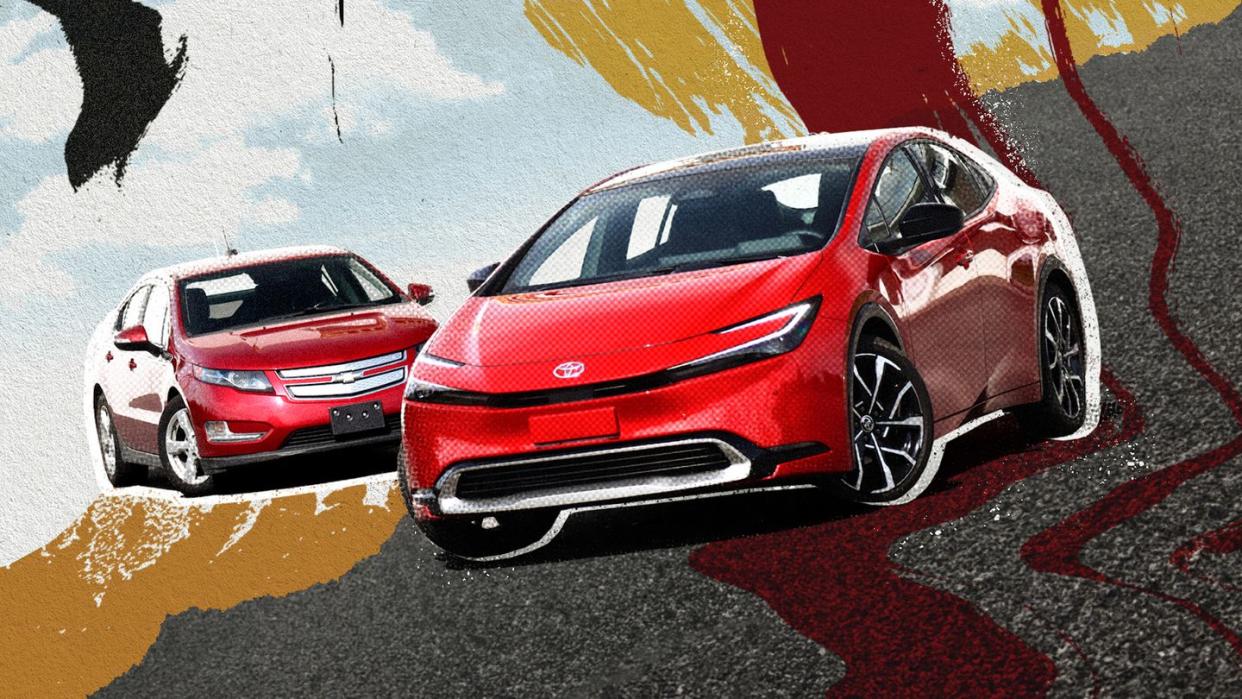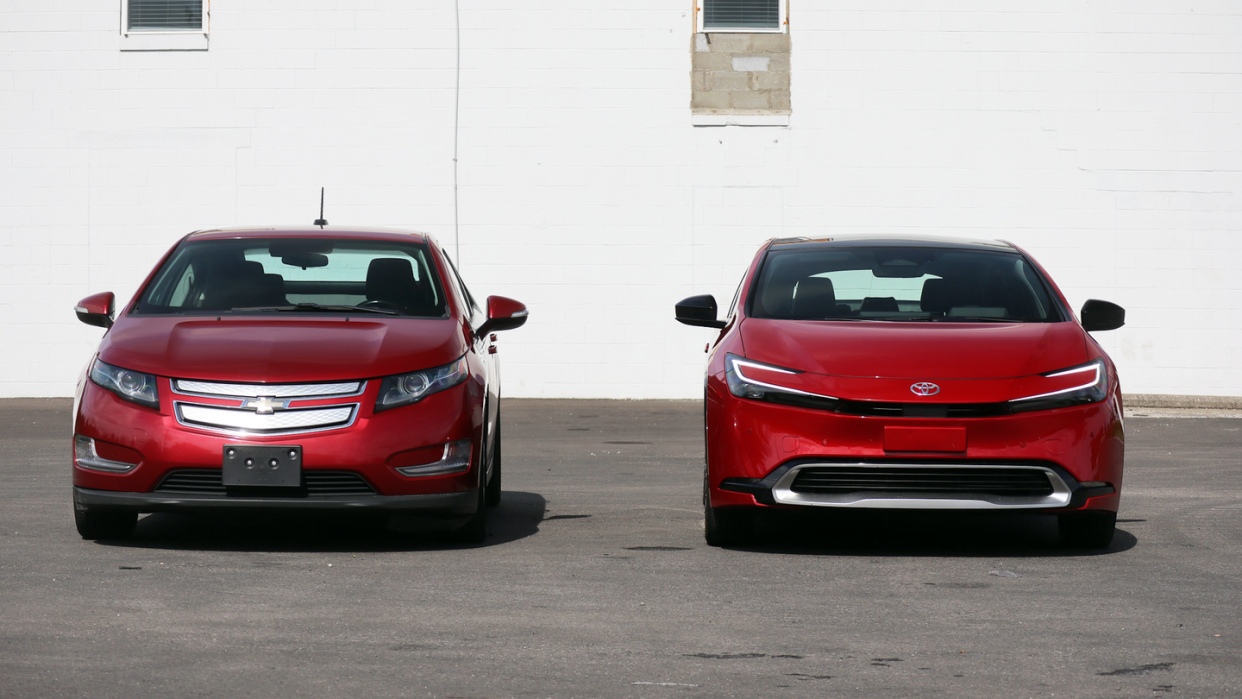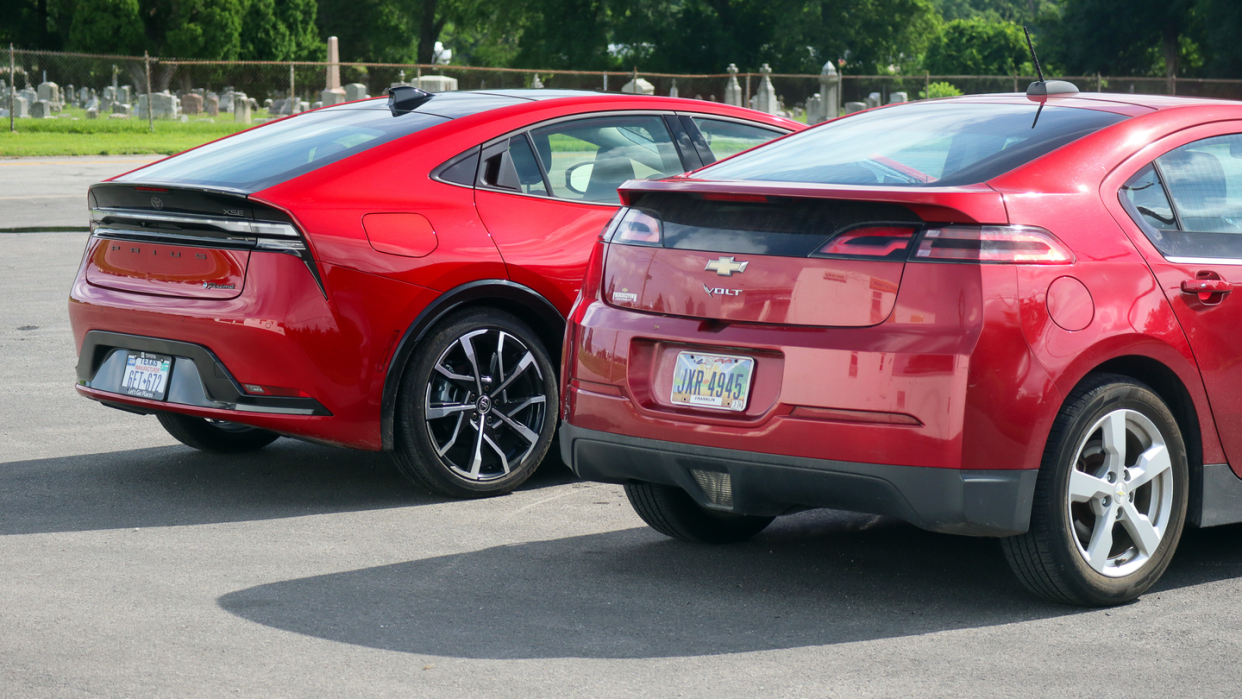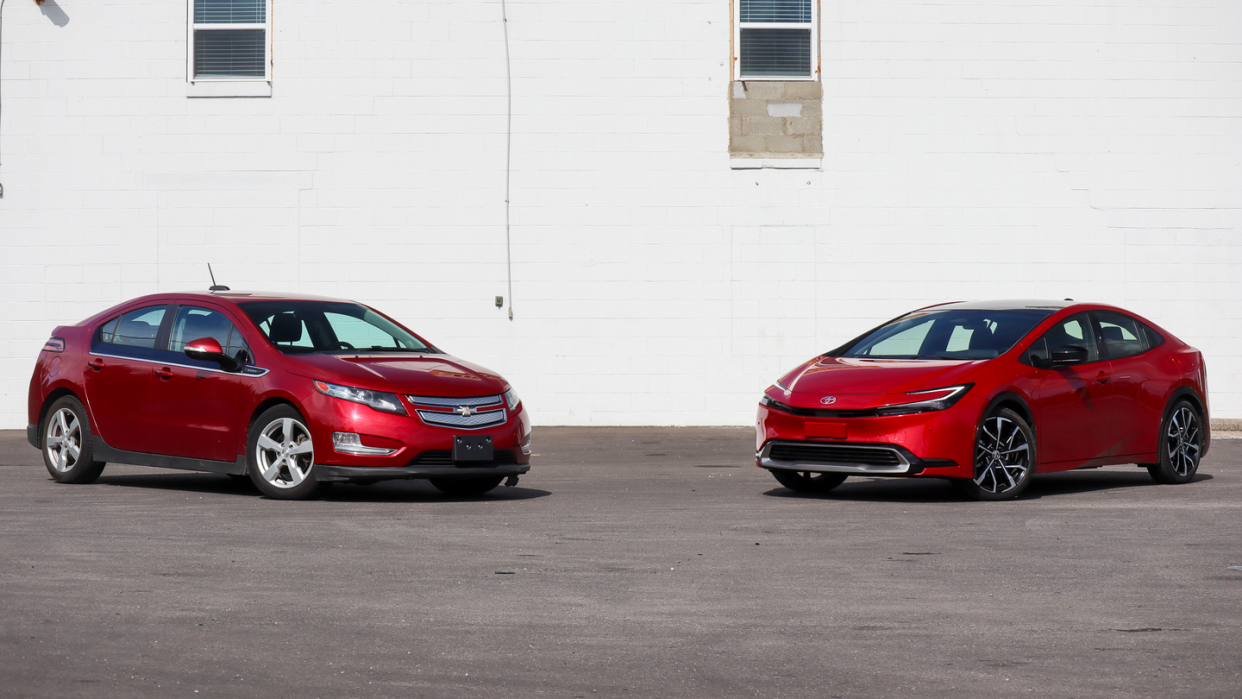How Does the Original Chevy Volt Hold Up Against the New Toyota Prius?


See, the Chevrolet Volt has the beginnings of an automotive cult classic. It’s the car version of Donnie Darko or Heathers, pieces of pop culture that debuted in an era when the general public just didn’t get it. Heathers was a critical and commercial flop when it was released in 1988, but time has only served to validate director Michael Lehmann’s vision. Looking back with modern eyes, it’s interesting to see how his movie was not only very good, but formed the blueprint for practically every satirical high school comedy since.
The Volt and Prius Prime sort of share a similar relationship. Although critics were generally positive about the Volt’s novel powertrain when it was new in 2010, missteps in communication (like the cringe-worthy Chevy Volt Dancers), and other confusing marketing tactics on GM’s end made the Volt become a cable news pundit’s punching bag. Despite two acts, GM pulled the plug on the car citing poor sales and poor profitability. Yet nearly 15 years later, nearly every single automaker has a PHEV. Did they improve on the Volt’s formula? I don’t know. Maybe.
The Volt and Prius Prime were so similar; they’re both five-door, smooth liftbacks – heck, the Supersonic Red presser is nearly the same color as the Crystal Red Metallic as my 2015 Volt, only further entrenching the idea that these are just the same car in a different font. Drag coefficients are similar too, ranking at 0.28 for the Volt, and 0.27 for the Prius Prime. They’re both plug-in hybrid vehicles that can travel just shy of 40 miles on electricity; 38 miles for a brand-new Volt, and 39 miles for my as-tested Prius Prime XSE.

The Volt’s design started life as the same platform that underpinned the first-generation Chevy Cruze, albeit with significant alterations to fit all the hybrid running gear. In 2023, the Volt feels awkwardly claustrophobic, the T-shaped 16kwh (17.1 in my 2015) battery runs down the spine of the car. True, the Volt has more headroom than the rakish Prius Prime, but the wide battery pushes the rear seats to the very sides of the car and removes any possibility of a fifth seat at all. The Volt doesn’t even use all of its battery; it’ll only use about 10-11 kWh before it turns on its engine. By comparison, the Prius Prime’s 13.6 kWh is downright petite. Its packaging is superior, the Prius Prime is about as roomy as its standard Prius HEV sibling. Toyota declined to share specific usable battery capacity specifications but judging from its nearly identical to the Volt’s Level 1 (at 12 amps) charging time, the Prius Prime’s usable battery capacity is likely around that same 10-11 kWh. Smaller battery pack, similar usability for the driver.
So, they’ve got the same battery capacity, shape, and color. But, after that, they differ greatly.
For starters, the Volt was electrified all the time. I describe it as a car that’s mostly electric, but with a gas engine that assists sometimes. That’s true – the Volt’s powertrain is mysterious, especially when it’s out of EV range. It’ll use electric power for most of its propulsion, with the gas engine interjecting at seemingly random times to recharge the battery or power the wheels, if the computer sees fit. The Prius almost feels reversed. Out of EV range, the Prius drives like a gas engine assisted by electricity. True, Toyota enlarged the electric motor in its eCVT for the Prius Prime, up to 160 HP instead of the roughly 75 HP in the plain HEV models. The Prius Prime’s hybrid system is business as usual when the Prius Prime is out of EV range; with its eCVT and gas motor doing the same dance it’s always done since the Prius came out back in 2001.

I did an impromptu, semi-scientific test. On an identical loop, with both cars’ climate control set at 72 degrees, with both driven in B or L modes respectively, the Prius saw 47.5 miles of full electric range, at 4.4 miles per kWh. The Volt managed a still respectable 38.6 miles, not bad considering my Volt has some battery degradation due to age, but only 3.7 miles per kWh. The Prius and Volt have roughly the same nine-ish second 0-60 time in EV mode, but the Prius dusts the Volt when it decides to use its gas engine. The Prius’s high 48 MPG combined when the car is in hybrid mode leaves the Volt’s 40 MPG far behind. There are definite improvements with the Prius Prime, but the improvement in drivability is only half the story.
The older Volt almost pleads with its clientele, attempting to make a case for itself in the face of an uninformed, circumspect, and slightly antagonistic public. Its user experience is informative, Whereas, the Prius Prime almost doesn’t give the driver the tools to understand and use it in the correct way.
The Volt’s gauge cluster, and its center-mounted infotainment screen split the duty of telling you your speed, but also power consumption. I can see how much electricity the Volt uses while accelerating or standing still, or how much energy it recuperates during regenerative braking. Its central screen displays granular data of how much I’ve consumed and how far I’ve driven on gas, electric, and hybrid power. It even has nifty driving tips and tricks integrated right into the car’s infotainment menu, meant to inform 2011-era consumers on how to get the most from their new PHEV. The Volt’s helpful information overload feels as if it’s convincing the end user of the validity of the entire premise of the PHEV concept.

By comparison, the Prius Prime’s lack of information just sort of assumes that the user automatically knows what these cars can do, naturally. Partially, it is true – by and large more drivers are informed about the capabilities of PHEVs, but the Prius almost presumes too much. For example, it may have a mile per kWH meter, but other specifics of the Prius’s drivetrain, are missing. The Prius’s Neo-Geo-esque Energy Monitor, a fixture of all Priuses, has been shoved in the metaphorical infotainment closet; stashed deep in several menus, also neutered and missing information compared to years past. Again, this used to be the Prius’ party trick! In the mid-Aughts, the only times you saw this much information about a car on a screen was in an R34 GT-R or a video game. The Prius’ in-dash screen tracked your daily MPG and real-time consumption like you were competing for a high score.
The Volt’s energy monitor equivalent and subsequent menus are more than just colorful doodads meant to impress techie passengers. The smart driver can tailor their driving style based on what they’re observing in real time from the vehicle’s data. The new Prius refuses to hand over that data, or even explain how the car works. The car’s buttons and modes took a 25-minute session of googling and pawing through an electronic owner's manual to figure out what they did. What was “auto?” What was “Regeneration Boost” and how do I even use it?
That last part might be one of the most important parts to achieving the best range in the Prius, and yet, there’s no easy way to find out what it even does, or how to use it. Regeneration Boost is Toyota speak for one-pedal driving; in EV mode, the Prius simulates the effect of low gearing engine braking by cranking its regenerating braking way, way up. But you’d never know that, it’s unclear how it even works, why it would be used, or what its limitations are. (The Prius’s B mode locks out cruise control, the Volt’s L mode does not.) I don’t think I would have been able to beat the Prius’s rated EV range without it. The Volt’s proto one pedal mode and instructions on how to use it, were listed in the helpful tips and tricks right in GM’s infotainment setup.

Maybe it’s a little silly to compare my old, 140,000 mile haggard example of a Volt, to a shiny new example of the Prius Prime, but I couldn’t help it. Fifteen years after the Volt’s initial announcement, all the pedantic punditry that surrounded the model has been lost to the ever-changing, fickle sands of internet culture. The inflammatory news segments and scathing articles don’t enter anyone’s memory, instead, it seems like time has only continued to validate the Volt’s premise because every single automaker has tried to copy the Volt’s formula in some form or another.
I just wish they’d copy more than the concept, there was a lot more to learn from the Volt than just using electricity and gas.

A car-lover’s community for ultimate access & unrivaled experiences.JOIN NOW Hearst Owned
You Might Also Like
